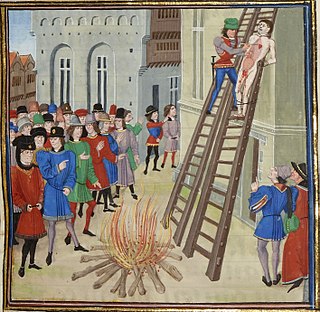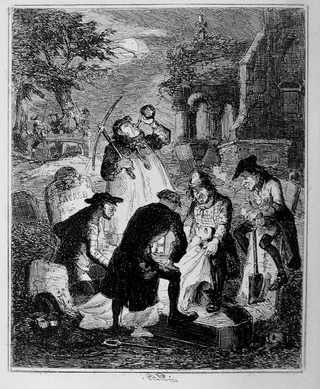Related Research Articles
Posthumous execution is the ritual or ceremonial mutilation of an already dead body as a punishment.

Urolagnia is a paraphilia in which sexual excitement is associated with the sight or thought of urine or urination. The term has origins in the Greek language. Golden shower is slang for the practice of urinating on another person for sexual pleasure, while watersports is the more inclusive term. However, Urophilia is not exclusively associated with sexual excitement.

Burial, also known as interment or inhumation, is a method of final disposition whereby a dead body is placed into the ground, sometimes with objects. This is usually accomplished by excavating a pit or trench, placing the deceased and objects in it, and covering it over. A funeral is a ceremony that accompanies the final disposition. Evidence suggests that some archaic and early modern humans buried their dead. Burial is often seen as indicating respect for the dead. It has been used to prevent the odor of decay, to give family members closure and prevent them from witnessing the decomposition of their loved ones, and in many cultures it has been seen as a necessary step for the deceased to enter the afterlife or to give back to the cycle of life.

Gibbeting is the use of a gallows-type structure from which the dead or dying bodies of criminals were hanged on public display to deter other existing or potential criminals. Occasionally, the gibbet was also used as a method of public execution, with the criminal being left to die of exposure, thirst and/or starvation. The practice of placing a criminal on display within a gibbet is also called "hanging in chains".

Westley Allan Dodd was an American convicted serial killer and sex offender who sexually assaulted and murdered three young boys in Vancouver, Washington, in 1989. He was arrested later that year after a failed attempt to abduct a six-year-old boy at a movie theatre in Camas Washington.

Body snatching is the illicit removal of corpses from graves, morgues, and other burial sites. Body snatching is distinct from the act of grave robbery as grave robbing does not explicitly involve the removal of the corpse, but rather theft from the burial site itself. The term 'body snatching' most commonly refers to the removal and sale of corpses primarily for the purpose of dissection or anatomy lectures in medical schools. The term was coined primarily in regard to cases in the United Kingdom and United States throughout the 17th, 18th, and 19th centuries. However, there have been cases of body snatching in many countries, with the first recorded case dating back to 1319 in Bologna, Italy.

Flaying is a method of slow and painful torture and/or execution in which skin is removed from the body. Generally, an attempt is made to keep the removed portion of skin intact.

Grave robbery, tomb robbing, or tomb raiding is the act of uncovering a grave, tomb or crypt to steal commodities. It is usually perpetrated to take and profit from valuable artefacts or personal property. A related act is body snatching, a term denoting the contested or unlawful taking of a body, which can be extended to the unlawful taking of organs alone.

Tsutomu Miyazaki was a Japanese serial killer who murdered four young girls in Tokyo and Saitama Prefecture between August 1988 and June 1989. He abducted and killed the girls, aged from 4 to 7, in his car before dismembering them and molesting their corpses. He also engaged in cannibalism, preserved body parts as trophies, and taunted the families of his victims.

A public execution is a form of capital punishment which "members of the general public may voluntarily attend." This definition excludes the presence of only a small number of witnesses called upon to assure executive accountability. The purpose of such displays has historically been to deter individuals from defying laws or authorities. Attendance at such events was historically encouraged and sometimes even mandatory.

Necrophilia, also known as necrophilism, necrolagnia, necrocoitus, necrochlesis, and thanatophilia, is sexual attraction or acts involving corpses. It is classified as a paraphilia by the World Health Organization (WHO) in its International Classification of Diseases (ICD) diagnostic manual, as well as by the American Psychiatric Association in its Diagnostic and Statistical Manual (DSM).

During World War II, some members of the United States military mutilated dead Japanese service personnel in the Pacific theater. The mutilation of Japanese service personnel included the taking of body parts as "war souvenirs" and "war trophies". Teeth and skulls were the most commonly taken "trophies", although other body parts were also collected.
Penis removal is the act of removing the human penis. It is not to be confused with the related practice of castration, in which the testicles are removed or deactivated, or emasculation, which removes both. Penis removal and castration have been used to create a class of servants or slaves called eunuchs in many different places and eras, having a notable presence in various societies such as Imperial China.

To be hanged, drawn and quartered was a method of torturous capital punishment used principally to execute men convicted of high treason in medieval and early modern Britain and Ireland. The convicted traitor was fastened to a hurdle, or wooden panel, and drawn behind a horse to the place of execution, where he was then hanged, emasculated, disembowelled, beheaded, and quartered. His remains would then often be displayed in prominent places across the country, such as London Bridge, to serve as a warning of the fate of traitors. The punishment was only ever applied to men; for reasons of public decency, women convicted of high treason were instead burned at the stake.

The practice of human trophy collecting involves the acquisition of human body parts as trophy, usually as war trophy. The intent may be to demonstrate dominance over the deceased, to humiliate or intimidate the enemy, or in some rare cases to commemorate the deceased. It can be done to prove one's body count in battle, to boast one's prowess and achievements to peers, or as a status symbol of superior masculinity. Serial killers' collection of their victims' body parts have also been described as a form of trophy-taking.

A video of U.S. Marines urinating on Taliban fighters was posted to websites in January 2012. The video was widely viewed on YouTube, TMZ and other sites, and caused anger and outrage in Afghanistan and the Middle East.

A drowning pit, drowning pool, murder-pool or murder hole was a well or pond specifically for executing women and girls under Scottish feudal laws. Rivers or lochans were used if conveniently situated near to a moot hill, where the baronial court dempster would announce the death penalty. The term fossa was also used, as in the phrase furca and fossa.

Resurrectionists were body snatchers who were commonly employed by anatomists in the United Kingdom during the 18th and 19th centuries to exhume the bodies of the recently dead. Between 1506 and 1752 only a very few cadavers were available each year for anatomical research. The supply was increased when, in an attempt to intensify the deterrent effect of the death penalty, Parliament passed the Murder Act 1752. By allowing judges to substitute the public display of executed criminals with dissection, the new law significantly increased the number of bodies anatomists could legally access. This proved insufficient to meet the needs of the hospitals and teaching centres that opened during the 18th century. Corpses and their component parts became a commodity, but although the practice of disinterment was hated by the general public, bodies were not legally anyone's property. The resurrectionists therefore operated in a legal grey area.
Necrophilia is a pathological fascination with dead bodies, which often takes the form of a desire to engage with them in sexual activities, such as intercourse. Though prohibited by the laws of many countries, there have been many reported cases of sexual abuse of dead bodies throughout history.

The desecration of graves involves intentional acts of vandalism, theft, or destruction in places where humans are interred, such as body snatching or grave robbing. It has long been considered taboo to desecrate or otherwise violate graves or grave markers of the deceased, and in modern times it has been prohibited by law. Desecration is defined as violating something that is sacred.
References
- ↑ One or more of the preceding sentences incorporates text from a publication now in the public domain : Chisholm, Hugh, ed. (1911). "Body-Snatching". Encyclopædia Britannica . Vol. 4 (11th ed.). Cambridge University Press. p. 112.
- ↑ Omissi, Adrastos (28 June 2018). Emperors and Usurpers in the Later Roman Empire: Civil War, Panegyric, and the Construction of Legitimacy. OUP Oxford. p. 36. ISBN 978-0-19-255827-5. Archived from the original on 7 November 2021. Retrieved 6 December 2021.
- ↑ Gantt, Darin (24 July 2014). "Modell family wants to press charges against grave urinator". Pro football Talk. Archived from the original on 6 December 2021. Retrieved 6 December 2021.
- ↑ Pettifer, Ernest (1992). Punishments of Former Days. Winchester: Waterside Press. p. 83. ISBN 978-1-8-72870-05-2.
- ↑ Harold Schechter; David Everitt (4 July 2006). The A to Z Encyclopedia of Serial Killers. Simon and Schuster. p. 290. ISBN 978-1-4165-2174-7. Archived from the original on 7 January 2014. Retrieved 27 January 2011.
- ↑ Goodwin, Robin; Cranmer, Duncan, eds. (2002). Inappropriate Relationships: The Unconventional, the Disapproved, and the Forbidden. London, England: Psychology Press. pp. 174–176. ISBN 978-0805837421.